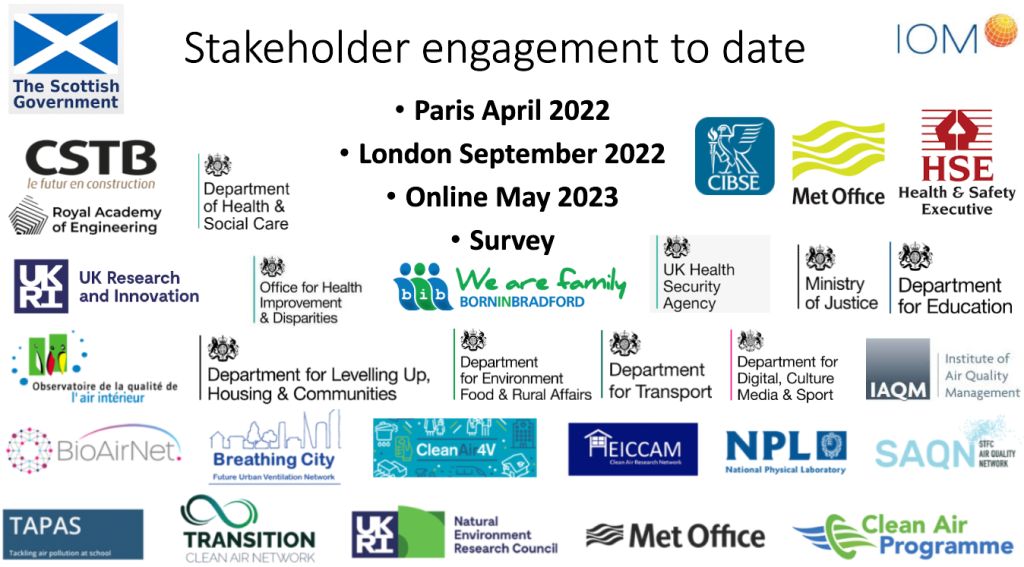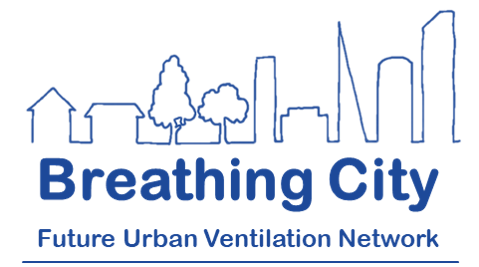An Indoor Air Quality Observatory to quantify health impacts of buildings
A national observatory for indoor air quality would provide essential longitudinal data to evidence the impact of the indoor environment on health. Data would enable effective interventions to be designed to improve public health, while at the same time providing evidence on building performance to support net zero targets and climate adaptation for the built environment. Support for this initiative would strengthen the case for funding opportunities. Most importantly, any input would ensure the effective design of the Observatory to maximise its health-benefit potential for the wider population.
This web-page provides background and information about the Indoor Air Quality Observatory vision, provides an archive of stakeholder engagement events to date, and shares upcoming events and plans. To get involved, share ideas, or find out more, email contact@breathingcity.org
Background
It is well recognised that air quality has a substantial impact on human health. The ability to relate outdoor air quality data to health outcomes has been achieved through the significant worldwide investment in networks of air quality sensors combined with models and analysis to evaluate spatial and temporal variation in air quality.
However, people spend around 90% of their time indoors, so the majority of air breathed is inside buildings and transport vehicles. As more attention is being focused to conserve energy, new buildings are being “sealed” having an impact on ventilation and chemical pollutants, biological agents that may accumulate indoors, as well as on physical parameters such as temperature and humidity.
There is growing awareness of the importance of indoor air quality and the wider indoor environment for health, with exposure to contaminants occurring within the built environment, from both indoor and outdoor sources. The COVID-19 pandemic has highlighted the importance of indoor environments for transmission of disease. The indoor environment also impacts on physical and mental health, as well as productivity, performance, decision making and creativity.
Proposed initiative
The establishment of an observatory for indoor air quality would coordinate the assessment of the impacts of the indoor environment on health. Its function would be to oversee indoor air monitoring activities and provide evidence for policy makers. It would involve government agencies, academics and consultants, develop guidance and protocols for monitoring indoor environments, provide a central repository for data storage, prioritise indoor air pollutants based on exposure and health effects, and provide training by developing policy briefs and information leaflets.
The observatory would enable future research characterising indoor sources, the differential toxicity of pollutants present in indoor air and people’s exposure to them, which will enable quantification of the burden of disease associated with a range of hazards in indoor environments. Data from the observatory would also support better understanding of building performance and therefore contribute towards policy goals such as progress towards net zero.
Engagement and support
Stakeholder engagement has thus far been successful in gaining strong support from the academic community, numerous Governmental departments’ scientific teams, and key senior air-quality and health figures. To strengthen the vision, we are now ready to engage with wider stakeholder groups such as industry, health charities, senior civil servants, MPs, and policy makers, and funders.
Stakeholder engagement to date

In May 2023, the Future Urban Ventilation Network (FUVN) and the Tackling Air Pollution At School Network (TAPAS) held an online facilitated workshop (hosted by The Collective) with key stakeholders to discuss the viability of a UK Indoor Air Quality Observatory. Key stakeholders were invited from across public policy, academia, funding bodies, and professional institutions.
Read more about the May 2023 event here
In September 2022, Breathing City (FUVN), TAPAS and ICP-ERG jointly hosted an in-person event in White City Campus, Imperial College London, which engaged discussions from academia, industry, and public policy around ‘Understanding IAQ for healthy buildings in a net zero world’ and focussed on early career researchers and indoor air studies. We heard presentations across a range of IAQ topics including monitoring, characterization methods, ventilation studies, modelling, IAQ health assessments and behavioural studies.
Read more about the Sept 2022 event here
In April 2022, members of the TAPAS network, the FUVN network, the CSTB and the OQAI met to discuss national indoor air quality strategies in France and the UK. The meeting of these four initiatives, together with invited experts from academia, industry and government science organisations, happened over two days in Paris and involved a series of presentations and workshops. A key focus of the meeting was on “observing indoor air” – how we can develop coordinated approaches to capturing data on indoor air quality at scale and over long periods of time and how this can be used to understand health effects and support policy and practice. The knowledge sharing and informative discussions will shape both the French and UK networks’ future indoor air quality studies and campaigns.
Read more about the April 2022 event here
Support for an Observatory
Through 2023 the Environmental Audit Committee is undertaking a short inquiry to establish the adequacy of current measures to promote indoor and outdoor air quality, and assess whether air quality targets are sufficient for protecting public health and the environment.
71 pieces of written evidence have been submitted and published. You can see the full list of submitted written evidence here. Multiple submissions highlighted the need for more indoor air quality monitoring, and discussed the importance of a whole-systems approach which brings together air quality scientists, health experts and the built environment sector.
The vision has been presented at the Clean Air Networks Conference (July 2023), at a cross-Government Indoor Air Quality Working Group meeting chaired by the Department of Health and Social Care (DHSC) (July 2023), and at the UKIEG conference (September 2023). We will also present the vision at the UKHSA annual conference (Nov 2023).
Looking forward
To strengthen the vision, we are now ready to engage with wider stakeholder groups such as:
- Industry (including architects, the ventilation sector, the AQ sensor sector and industry representatives such as BESA, IMechE, CIBSE and RAEng)
- Health charities
- Senior civil servants, MPs, and policy makers
- Funders
- Social sciences i.e behaviourists
We also plan to continue to engage with our existing communities to ensure they are kept up to date with the progression of the IAQ Observatory vision in the context of the wider stakeholder engagement and have the opportunity to input their expertise and opinions at appropriate stages. These groups and engagement strategies include:
- Academic community – through regular website updates, involvement in future workshops where appropriate and through quarterly meetings with Clean Air Programme Principal Investigators and associated Clean Air Champions.
- Governmental departments’ scientific teams – through sharing regular website updates, and involvement in future workshops where appropriate.
